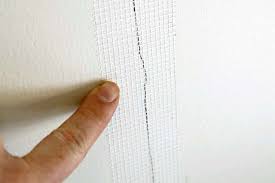Fortunately, fixing a drywall crack is easy. Although the exact method depends on the type of crack, it’s a fairly straightforward process. Once you understand the process and how each step works, you can tackle the job without difficulty. In this article, we’ll explore some of the best methods, including Spackle and Drywall mud. This article is not intended as a comprehensive guide to drywall repair.
Caulk
If a crack in drywall keeps coming back, you might need to make repairs. A putty knife works well to remove loose wall material, and a razor blade scraper can clean hard surfaces. Before you re-caulk, make sure the area is clean and free of loose paint or other materials. After removing loose material, clean the area with a vacuum cleaner. The clean surface will ensure a strong bond when you re-caulk the crack.
Caulk is a flexible adhesive that works well for filling cracks. It works well for small stress fractures and is compatible with moisture. It can also handle normal house settling and wall flexing caused by temperature changes. When you apply caulk, you can smooth the surface of the crack and paint it the same color as the wall around it. After it is dry, you can paint the area to cover it.
Drywall mud
A typical crack in a wall can be repaired using drywall mud, but it might not be enough to solve the problem. You need to widen the crack so that you can apply patching material to it and fill in the hole. To do this, use a putty knife to smooth the edges of the crack. Once it is completely dry, you can paint it and then add a coat of finishing plaster.
Another way to fix a crack in drywall is by re-taping the joint. This involves scraping off the damaged tape and sanding the surface smooth. Apply drywall compound to fill the crack and then apply a new tape. This method is effective for repairing minor cracks in drywall. While it doesn’t solve the problem completely, it will save you from having to use more expensive and time-consuming repair methods.
Spackle
Whether you have a small crack or a large one, you probably want to try to patch it as soon as possible. Unfortunately, spackle won’t cover a crack in drywall; it will only mask it. Luckily, you can buy fiberglass mesh drywall tape at your local home improvement store. This tape is flexible, which means it will be more likely to cover the crack than a patch would.
Before attempting to repair a drywall crack, you should first apply patch primer, which acts like joint compound. Apply the primer thinly over fiberglass tape and wait at least 30 minutes for it to dry. If the crack is large enough, apply several strips of tape and allow the primer to dry before attempting to repair it. After the patch primer has cured, apply the final layer of drywall compound.
Uneven foundation
Cracks in drywall may be caused by uneven settling or shifting of your home’s foundation. Look for patches that have been applied to repair the crack. Patches are often made with a rougher surface and tend to resemble small humps. A professional foundation repair company can inspect and repair any foundation problems. Cracks in drywall may be the first indication of a foundation problem.
If you’ve noticed gaps or rippling drywall in the interior, it’s possible that your home has an uneven foundation. Cracks around windows and doors may be caused by foundation movement. If you see cracks in drywall that keep coming back, you should have your foundation checked. A professional should also examine the window and door frames to make sure they’re level and not affected by foundation movement.
Humidity fluctuations
A crack in drywall can occur for several reasons, including faulty taping or structural damage. Most cracks are not dangerous, but they can be an eyesore. Occasionally, a crack can be repaired by applying spackle and repainting, but in some cases, it may come back, getting deeper and more noticeable. Homeowners who have just purchased a new home may also find a crack in the drywall. New lumber will take some time to dry, and that moisture will eventually seep into the wall.
When seasonal temperatures fluctuate, drywall expands and contracts, which can cause a crack. Building codes require expansion joints on walls longer than 30 feet. Even shorter walls are susceptible to seasonal changes, so they may crack. Wood framing can be prone to cracking, so consider installing an expansion joint in the wall before you begin the repair process. Humidity fluctuations may cause a crack in drywall to come back, but it’s worth it to prevent this from occurring in the first place.

